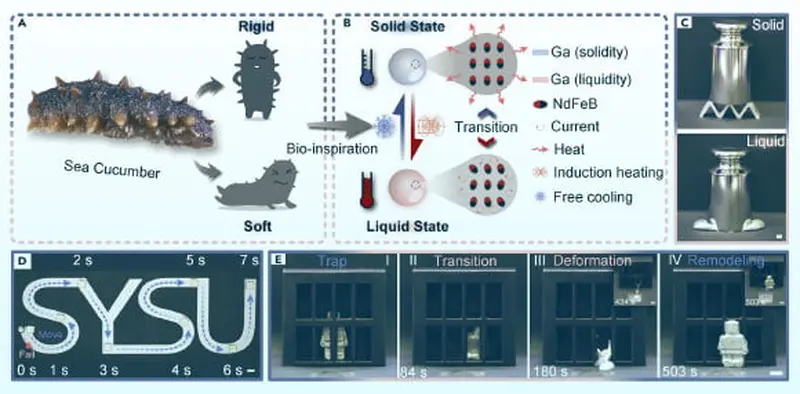A team of Chinese and American scientists has created a robot that can easily change its state of matter.
Researchers from Sun Yat-sen University, the Chinese University of Hong Kong, Zhejiang University (China), and Carnegie Mellon University (USA) are confident that their invention will be useful in many fields. It can, in particular, be applied in medicine and microelectronics.
In the reported video, the team showcases a small robot prisoner transforming into a liquid and escaping from a closed cage. To create such a shapeshifter, scientists developed a non-toxic material based on gallium. This metal has a very low melting point of about 29.8 °C. To obtain the so-called magneto-active phase transition material (MPTM), the team “embedded” magnetic microparticles into the gallium. Under the influence of an alternating magnetic field, the robot made from this new material was able to transition from one state of matter to another. This was explained by Dr. Carmel Majidi, the lead author of the study from Carnegie Mellon University.
According to him, magnetic micro-particles cause the MRI to react to the changing magnetic field. Thus, the material can be heated through induction and induce a phase change, it reports. Sci.news .

The scheme and application of the liquid-solid phase transition MPTM.
Image author: Wang et al., doi: 10.1016/j.matt.2022.12.003.
What a robot – the successor of the Terminator – is capable of.
Interestingly, the inventors of the robot were inspired not by a famous movie character known for virtuously changing its state of matter, but by real living creatures that can be soft or hard, like stone. For example, sea cucumbers.
Granting robots such capabilities endows them with remarkable functionality, noted Chengfen Pan from the Chinese University of Hong Kong.
During the study, scientists tested the mobility and strength of the material under various conditions. The robots jumped over trenches, climbed walls, and even split in half to move an object before reassembling themselves. Additionally, the shape-shifting robots removed foreign objects from the stomach model and delivered medication to the same artificial stomach.
Robots were also tested as universal mechanical “screws” for assembling parts in hard-to-reach places. Finally, they were used for repairing wireless circuits.
However, as Carmel Majidi believes, these are just one-time demonstrations, proof of concept. To understand how the work can be fully utilized for the same removal of foreign objects, a lot of new research will be needed.

